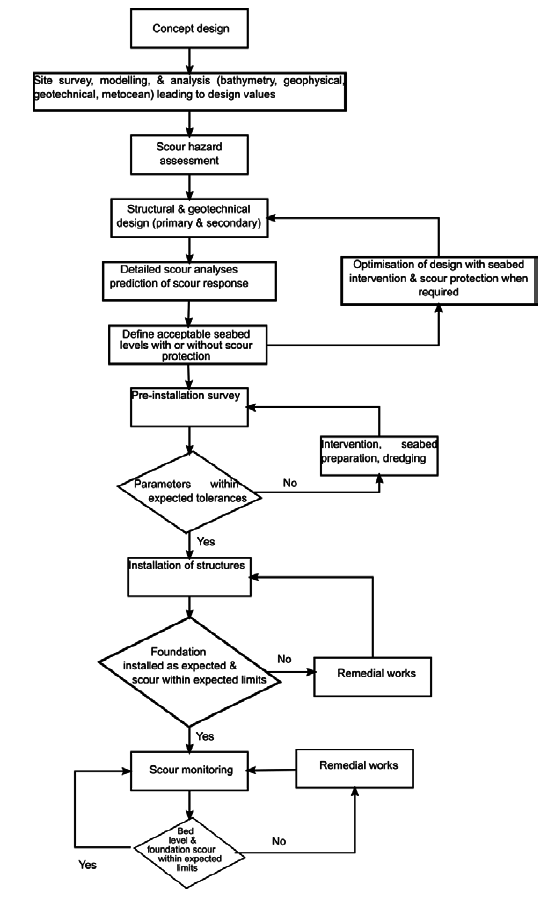6.2.1 A high level indication of the likelihood and magnitude of scour can be achieved by
the use of indicators of potential mobility and erosion as described by
Whitehouse et al. (2011) and presented in
Table 3.6.1 Examples of seabed hazards and mitigation. This high-level assessment may then be followed by a more
detailed assessment.
Table 3.6.1 Examples of seabed hazards and mitigation
| Sand – indicators of mobility
|
Clay – indicators of erosion
|
| Ripple marks
|
Longitudinal furrows or grooves
|
| Megaripples
|
Obstacle marks – scour around rocks or
other debris on the seafloor
|
| Sandwaves
|
|
| Obstacle marks – scour and deposition
around rocks or other debris on the seafloor
|
|
6.2.2 If sandwaves, or other mobile features, are identified in the development area it is
important for future decision making to understand how these features may change
with time and what impact they may have on the foundations. For example, the speed
and direction of movement of sandwaves should be assessed; potentially by comparison
of different surveys.
6.2.3 Following the recommendations of Whitehouse (2006), a scour
assessment should aim to assess whether or not scour may occur for certain return
period events. If scour is a significant risk, then a more detailed assessment
should be performed to determine the depth and extent of scour and how quickly it
will develop. The assessment should consider that scour may occur either during, or
as a result of, the construction process itself, soon after installation or during
operation.
6.2.4 Whitehouse (1998) presents a general approach to assessing scour hazard that
considers input of wind, waves and current in combination with soils data and
structural characteristics to provide an overall scouring status. A combination of
results on likelihood and magnitude of scour give an assessment of scour hazard or
risk.
6.2.5 This assessment may be supplemented by the use of techniques such as physical
modelling or computational fluid dynamics to give improved predictions.
6.2.7 Generally speaking, scour can be classified into one of the categories below:
- significant scour, erosion or deposition is unlikely;
therefore, no action in design or construction is required. Routine
structural inspection may be used to confirm that this remains the case
throughout an asset's life. If inspection does identify scour beyond that
included in the design, then further engineering or remedial action may be
required; and
- significant scour, erosion or deposition is expected. This may either be
accounted for by use of a design scour allowance(s) scour protection, or a
combination of both.
6.2.8 When setting design scour allowances the following aspects should be considered:
- sensitivity of structure capacity and performance to scour; combined with
the likelihood and potential impact of scour exceeding the design scour
allowance;
- a design scour allowance is likely to form the main basis for inspection
criteria;
- ability to detect and respond to excessive scour before it proves
problematic to the foundation performance or capacity;
- whether different design scour allowances may be applicable for difference
design conditions – for example, FLS, ULS or ALS; and
- a scour management plan also requires definition of inspection during
installation and in-service with the use of remedial works where scour is
found to be excessive; or it is determined scour may exceed the limits set
during design. It is important to note that scour magnitude may increase or
decrease with time; therefore, an annual inspection may not necessarily
capture the full extent of scour that has occurred.

Figure 3.6.2 Scour management plan (reproduced from Whitehouse et al., 2011)